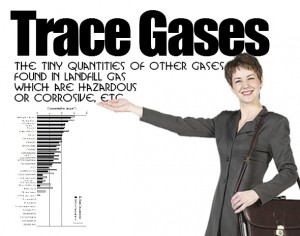 This article discusses the trace gases likely to be present in the landfill gas from a typical United Kingdom Landfill, and provides some pointers to sources of further information available on this subject.
This article discusses the trace gases likely to be present in the landfill gas from a typical United Kingdom Landfill, and provides some pointers to sources of further information available on this subject.
That this is clearly of interest to our visitors is shown by the frequent occasions when people have searched for this information, using our website search facility.
The reason for this lies in the fact that over 500 trace components have been identified as trace gases in UK landfill gas to date. The trace components have chemical or physical properties that differ significantly from the bulk gases. Also, it is known that some of these trace components, when present above threshold concentrations, cause physiological effects and thus have potential health impacts.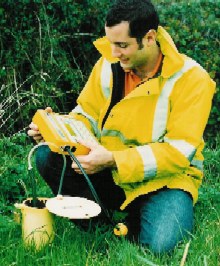
Just 62 landfill gas trace substances were then more recently identified within the landfill gas source-term as those from the list of 500, being likely to be present at a significant concentration and to be worthy of further consideration.
Hydrogen sulphide, chloroethene (vinyl chloride), carbon disulphide and the BTEX group of compounds typically exhibited the highest concentrations of the analytes within the landfill gas source-term, during recent research(1) . Dichlorofluoromethane (Freon 21) was detected in the highest concentrations but is not regarded as significant because of its relatively low potential toxicological or odour impact.
Figure 1. Mean and median concentrations of trace components of particular interest(1)
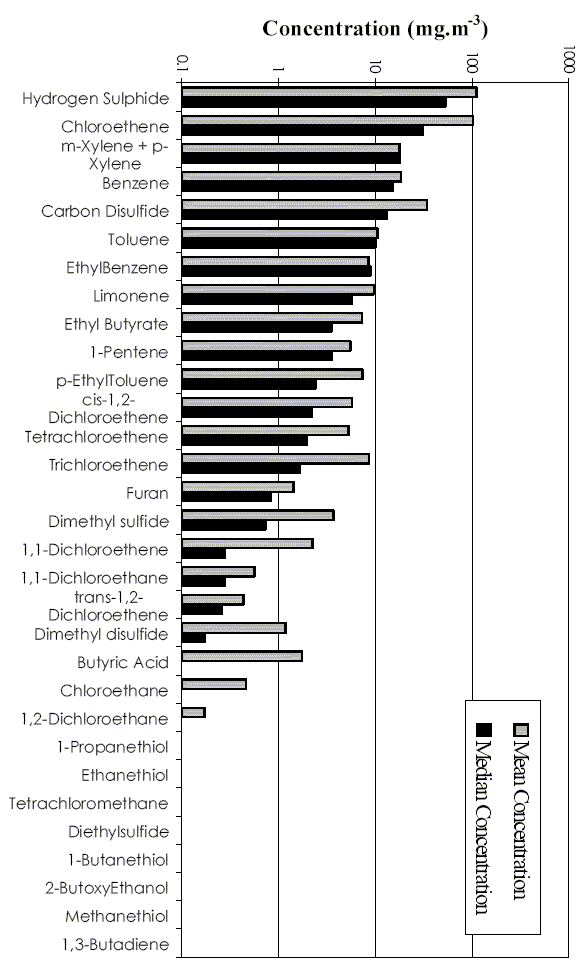 |
Thus, it has been possible to remove some substances from the latest list, and a reduced list of 25 substances has been proposed, based on either odour or health impact.(7)
The list we have shown here is slightly longer, as now proposed(1), and is known as the list of “priority” trace landfill gas components at a ‘typical' UK landfill. The list is as follows(1) :-
Chloroethane, chloroethene, benzene, 2-butoxy ethanol, arsenic, 1,1-dichloroethane, trichloroethene, tetrachloromethane, methanal, hydrogen sulphide, cis-1,2-dichloroethene, trans-1,2-dichloroethene, 1,1-dichloroethene, furan, 1,3-butadiene, mercury, carbon disulphide, methanethiol, butyric acid, ethanal, 1-propanethiol, dimethyl disulphide, ethanethiol, 1-pentene, ethyl butyrate, dimethyl sulphide, 1-butanethiol.
Another substance present in landfill gas and also for example in sewage sludge is siloxane. Siloxane has a very damaging effect on landfill gas engines unless they are adequately protected.
The Environment Agency's landfill gas modelling software incorporates trace element modelling.
The information on this page has been primarily derived from Reference 1. However, in order to gain a useful understanding of trace landfill gas compounds we recommend reading the following, in addition to Reference 1:-
- J. Hillier, T. Parker and A. Rosevear. Assessment of Trace Components in Landfill Gas from “Typical” UK Sites. Proceedings of Waste 2004, Integrated Waste Management and Pollution Control: Research, Policy and Practice. September 2004, Stratford-upon-Avon.
- Environment Agency, 2002. GasSim – landfill gas risk assessment tool. R&D Project report P1- 295, GasSim Model and User Manual, Environment Agency, Bristol. A free demonstration version is available at http://www.gassim.co.uk
- Environment Agency, 2003a. Investigation of the Composition and Emissions of Trace Components in Landfill Gas. P1-438/TR. Environment Agency, Bristol. ISBN: 1 84432 018 9
- Environment Agency, 2003b. Quantification of Trace Components in Landfill Gas. R&D Project report P1-491. Environment Agency, Bristol.
- McKendry, P. J., McKensie, A. and, Looney, J. H., 2002a. Landfill Odour Risk Assessment and Mitigation Measures. Proceedings of Waste 2002, Integrated Waste Management and Pollution Control: Research, Policy and Practice. September 2002, Stratford-upon-Avon.
- McKendry, P. J., Looney, J. H., and, McKensie, A., 2002b. Managing Odour Risk at Landfill Sites: Main Report. Viridis and Millennium Science and Engineering Ltd.
- Parker, T.M., Dottridge, J., Kelly, S., Rosevear, A., 2002. Prioritising Trace Components of Landfill Gas in the UK. Proceedings of Waste 2002, Integrated Management and Pollution Control: Research, Policy and Practice. September 2002, Stratford-upon-Avon.
- Parker, T.M., Apps, G., Rosevear, A., 2003. Evaluation of chemical analysis techniques for trace components of landfill gas. SARDINIA 2003. Ninth International Waste Management and Landfill Symposium. S. Margherita di Pula (Cagliari, Italy), October 2003.
Other Pages You May Find Interesting:
[catlist]
Landfill Gas Analysis and Baseline Emissions Determination
There are a number of “standard” landfill gas analysis reports which provide tables showing the amount of methane, and other main constituents of landfill gas such as carbon dioxide and these usually also include data for hydrogen sulphide and carbon monoxide. They also frequently list the “trace chemicals” which have been found in the gas. However, it […]

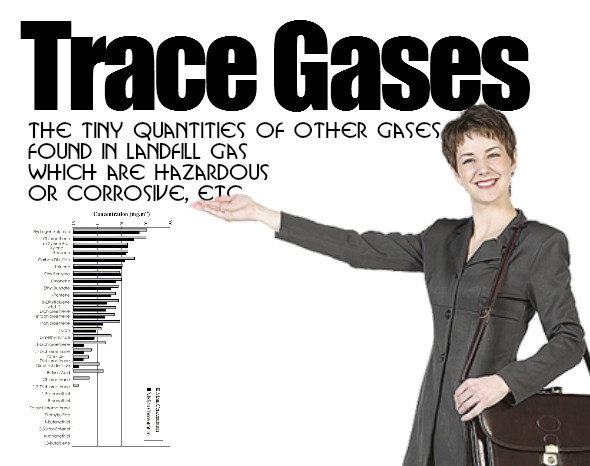
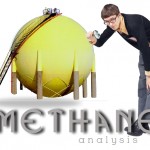
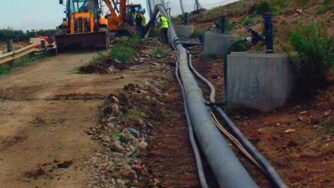
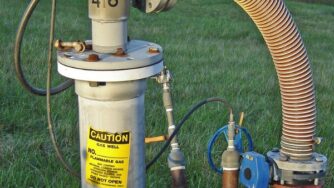
What equipment other than a gas probe is needed to detect for this?
Is the smell of a landfill the landfill gas, or just the rotting on the surface?